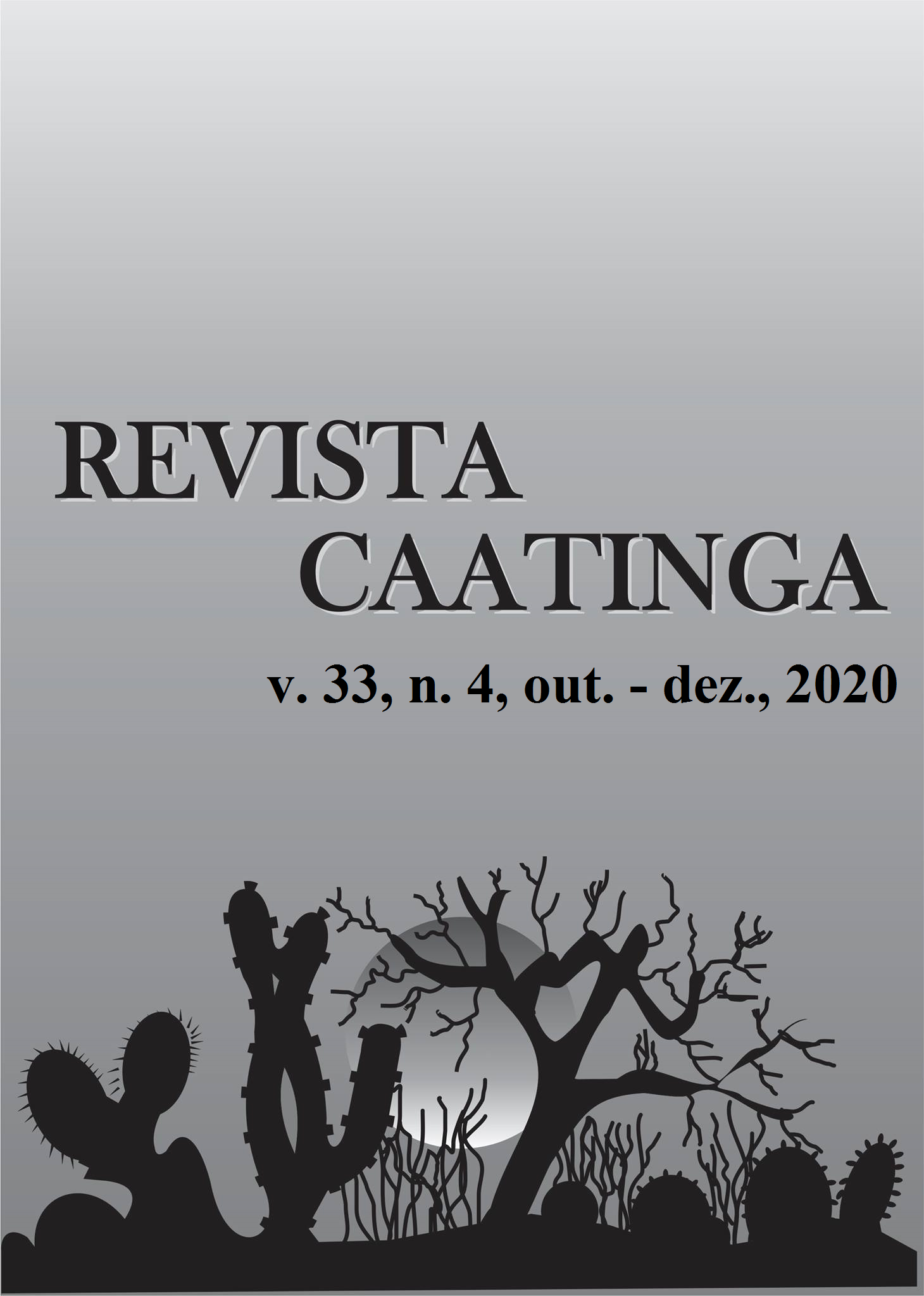PLOT SIZE, NUMBER OF TREATMENTS AND REPLICATES AND EXPERIMENTAL PRECISION IN BUCKWHEAT
DOI:
https://doi.org/10.1590/1983-21252020v33n428rcKeywords:
Fagopyrum esculentum Moench. Soil cover crop. Uniformity trial. Experimental design.Abstract
The objective of this work was to determine the optimal plot size to evaluate the fresh weight in buckwheat (Fagopyrum esculentum Moench) of the IPR91-Baili and IPR92-Altar cultivars, in scenarios formed by combinations of numbers of treatments, numbers of replicates, and levels of experimental precision. Sixteen uniformity trials (blank experiments) were carried out, eight with cultivar IPR91-Baili and eight with cultivar IPR92-Altar. The trials were performed in eight sowing dates. The fresh weight was evaluated in 576 basic experimental units (BEU) of 1 m × 1 m (36 BEU per trial). The soil heterogeneity index of Smith (1938) was estimated. The plot size was determined by the method of Hatheway (1961) in scenarios formed by combinations of i treatments (i = 5, 10, 15, and 20), r replicates (r = 3, 4, 5, 6, 7, and 8), and d precision levels (d = 10%, 11%, 12%, 13%, 14%, 15%, 16%, 17%, 18%, 19%, and 20%). To evaluate the fresh weight in buckwheat of the IPR91-Baili and IPR92-Altar cultivars, in experiments under completely randomized and randomized block designs, with 5 to 20 treatments and eight replicates, plots of 8 m2 of useful area are sufficient to identify significant differences between treatments, at 5% probability level, of 15% of the overall mean of the experiment.
Downloads
References
ACCAME, M. E. C.; ORTEGA, T. Trigo sarraceno. Panorama Actual del Medicamento, 43: 133-136, 2019.
ALVARES, C. A. et al. Köppen’s climate classification map for Brazil. Meteorologische Zeitschrift, 22: 711-728, 2013.
CARGNELUTTI FILHO, A. et al. Planejamentos experimentais em nabo forrageiro semeado a lanço e em linha. Bioscience Journal, 30: 677-686, 2014b.
CARGNELUTTI FILHO, A. et al. Plot size related to numbers of treatments, repetitions, and the experimental precision in flax. Comunicata Scientiae, 9: 629-636, 2018.
CARGNELUTTI FILHO, A. et al. Tamanho de parcela para avaliar a massa de plantas de mucuna cinza. Comunicata Scientiae, 5: 196-204, 2014a.
DONATO, S. L. R. et al. Experimental planning for the evaluation of phenotipic descriptors in banana. Revista Brasileira de Fruticultura, 40: 1-13, 2018.
GONÇALVES, F. M. F. et al. Fagopyrum esculentum Moench: A crop with many purposes in agriculture and human nutrition. African Journal of Agricultural Research, 11: 983-989, 2016.
GÖRGEN, A. V. et al. Produtividade e qualidade da forragem de trigo-mourisco (Fagopyrum esculentum Moench) e de milheto (Pennisetum glaucum (L.) R.BR). Revista Brasileira de Saúde e Produção Animal, 17: 599-607, 2016.
GUIMARÃES, B. V. C. et al. Methods for estimating optimum plot size for ‘Gigante’ cactus pear. Journal of Agricultural Science, 11: 205-211, 2019.
GUIMARÃES, B. V. C. et al. Optimal plot size for experimental trials with Opuntia cactus pear. Acta Scientiarum. Technology, 42: e42579, 2020.
HATHEWAY, W. H. Convenient plot size. Agronomy Journal, 53: 279-280, 1961.
MAYOR-DURÁN, V. M.; BLAIR, M.; MUÑOZ, J. E. Metodología para estimar el coeficiente de heterogeneidad del suelo, el número de repeticiones y el tamaño de parcela en investigaciones con frijol (Phaseolus vulgaris L.). Acta Agronomica, 61: 32-39, 2012.
MIKHAILOVICH, G. N. Las bases para cultivo de alforfón (trigo sarraceno) Fagopyrum esculentum en centroamérica. Revista Científica Tecnológica, 2: 8-13, 2019.
PEREIRA, A. P. et al. C. Ciclagem de nutrientes por plantas de cobertura de verão. Revista de Ciências Agrárias, 40: 799-807, 2017.
PIMENTEL-GOMES, F. Curso de estatística experimental. 15. ed. Piracicaba, SP: FEALQ, 2009. 451 p.
R Development Core Team R: A Language and Environment for Statistical Computing. Vienna: R Foundation for Statistical Computing. 2020.
SANTOS, H. G. et al. Sistema Brasileiro de Classificação de Solos. 5. ed. revisada e ampliada. Brasília, DF: Embrapa, 2018. 356 p. Disponível em: <https://www.infoteca.cnptia.embrapa.br/handle/doc/1094003>. Acesso em: 23 mar. 2020.
SKORA NETO, F.; CAMPOS, A. C. Plantas de cobertura antecedendo a cultura de trigo. Scientia Agraria Paranaensis, 16: 463-467, 2017.
SMITH, H. F. An empirical law describing heterogeneity in the yields of agricultural crops. Journal of Agricultural Science, 28: 1-23, 1938.
SOUSA, R. P. et al. Optimum plot size for experiments with the sunflower. Revista Ciência Agronômica, 46: 170-175, 2015.
SOUSA, R. P.; SILVA, P. S. L.; ASSIS, J. P. Tamanho e forma de parcelas para experimentos com girassol. Revista Ciência Agronômica, 47: 683-690, 2016.
STORCK, L. et al. Experimentação vegetal. 3. ed. Santa Maria, RS: UFSM, 2016. 198 p.
YILMAZ, H. Ö.; AYHAN, N. Y.; MERIÇ, Ç. S. Buckwheat: A Useful Food and its Effects on Human Health. Current Nutrition & Food Science, 16: 29-34, 2020.
ZIECH, A. R. D. et al. Proteção do solo por plantas de cobertura de ciclo hibernal na região Sul do Brasil. Pesquisa Agropecuária Brasileira, 50: 374-382, 2015.
Downloads
Published
Issue
Section
License
Os Autores que publicam na Revista Caatinga concordam com os seguintes termos:
a) Os Autores mantêm os direitos autorais e concedem à revista o direito de primeira publicação, com o trabalho simultaneamente licenciado sob a Licença Creative Commons do tipo atribuição CC-BY, para todo o conteúdo do periódico, exceto onde estiver identificado, que permite o compartilhamento do trabalho com reconhecimento da autoria e publicação inicial nesta revista, sem fins comerciais.
b) Os Autores têm autorização para distribuição não-exclusiva da versão do trabalho publicada nesta revista (ex.: publicar em repositório institucional ou como capítulo de livro), com reconhecimento de autoria e publicação inicial nesta revista.
c) Os Autores têm permissão e são estimulados a publicar e distribuir seu trabalho online (ex.: em repositórios institucionais ou na sua página pessoal) a qualquer ponto antes ou durante o processo editorial, já que isso pode gerar alterações produtivas, bem como aumentar o impacto e a citação do trabalho publicado (Veja O Efeito do Acesso Livre).







